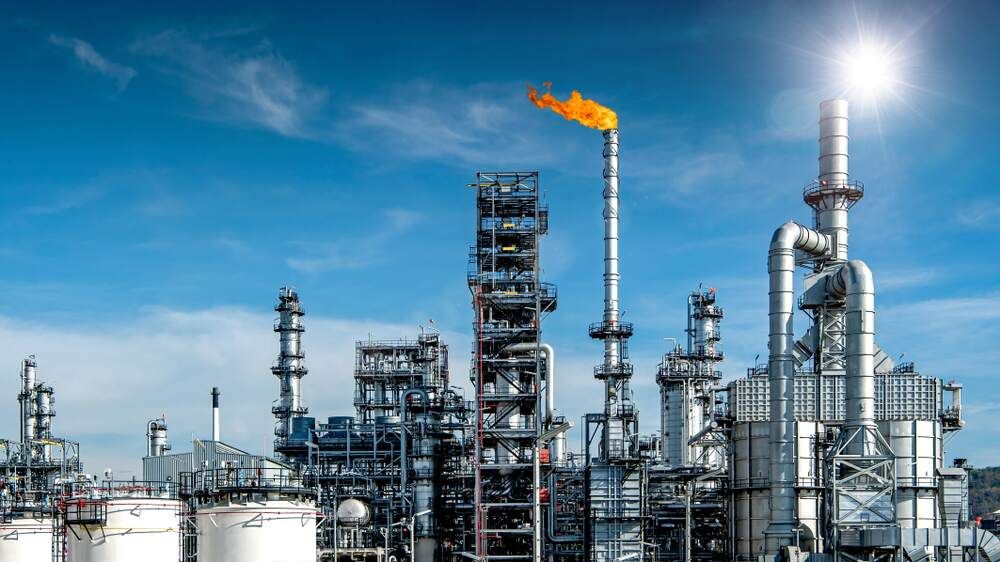Petrochemical & Refining
PROVIDING INNOVATIVE MEASUREMENT SOLUTIONS
PETROCHEMICAL INDUSTRY
Delivering Safety & Process Monitoring Solutions, You Can Trust
The petrochemical industry holds a prestigious position as a global powerhouse, making substantial contributions to the world economy. It plays a pivotal role in supplying the raw materials necessary for the production of a wide array of chemical products, pharmaceuticals, fertilizers, solvents, and plastics. The exploration and processing of crude oil into valuable fuel oil and gasoline form the backbone of this industry, fueling numerous sectors worldwide.
Process Insights is your SINGLE SOURCE for complete flare gas analysis for total compliance – Quad O, HON, MON and EMACT, RSR, Subpart Ja, HRVOC and more.
Our analyzers are specifically designed to cater to the unique requirements of petrochemical processing, delivering precise and reliable measurements of moisture, oxygen, and hydrogen levels. By employing our state-of-the-art technology, petrochemical facilities can effectively monitor and control these critical parameters in real-time. This allows for swift detection of any deviations or abnormalities, enabling prompt corrective actions to be taken to ensure the integrity and efficiency of the processes.
We know your process and how critical it is for you to protect precious and limited resources. We offer many high performance, affordable, turnkey solutions for your application. Explore our Application Support.
-

FLARE GAS MONITORING
EXTREL™ Quadrupole Mass Spectrometer and COSA XENTAUR™ BTU Wobbe Calorimeters are two types of analytical instruments that can be used to monitor flare gas emissions and ensure compliance with regulations. We also offer our ATOM INSTRUMENT™ FGA-1000™ Flare Gas Analyzer as an ideal online process analyzer utilizing patented Excimer UV Fluorescence (EUVF) Technology to measure Total Sulfur in refinery flare gas and subsequent sulfur dioxide (SO2) emissions as mandated by the EPA Rule 40 CFR 60, Subpart Ja.
Process Insights is your SINGLE SOURCE for complete flare gas analysis for total compliance – Quad O, HON, MON and EMACT, RSR, Subpart Ja, HRVOC and more.
Our gas analyzer solutions for flare gas monitoring include:
DOWNLOAD Solutions for Flare Gas Flyer
DOWNLOAD Solutions for Refinery Flyer
-

CRUDE OIL PROCESSING
Crude oil processing for naphtha conversion is a refining process that involves the conversion of heavy crude oil into lighter hydrocarbon products, such as naphtha, which is a feedstock for petrochemical production. Our ANALECT® Series of FTIR/FT-NIR Process Analyzers are widely used in crude oil processing applications.
DOWNLOAD Solutions for Flare Gas Flyer
DOWNLOAD Solutions for Refinery Flyer
-

FUEL COLOR AND TURBIDITY
Fuel color and turbidity are important characteristics of fuels because they can affect the performance and efficiency of engines that use the fuel. Our GUIDED WAVE™ NIR Spectrometers are commonly used to monitor fuel color and turbidity. These instruments use near-infrared (NIR) light to measure the properties of a substance, including the color and turbidity of a fuel.
DOWNLOAD Solutions for Refinery Flyer
-

HYDROCARBON PROCESSING
Spectroscopy is an industry-proven tool for the real-time monitoring of reaction conditions and subsequent grading of finished petrochemical products in a refinery. Our GUIDED WAVE™ Near-Infrared (NIR) spectroscopy is used to monitor the hydrocarbon composition of various streams.
Learn how our RUGGED PROBES & FLOW CELLS MEET REFINERY REQUIREMENTS.
DOWNLOAD Solutions for Refinery Flyer
-

Industrial Boilers
Monitoring the Total Organic Carbon (TOC) levels in the condensate from heat exchangers is crucial in boilers. When TOC levels exceed acceptable limits, immediate action is required to divert the condensate away from the boiler to avoid potential damage. By implementing continuous TOC monitoring, operators can swiftly make necessary adjustments, effectively preventing equipment damage, production downtime, and financial losses.
Our solutions include:
- TOC Water Analyzer for Harsh Wastewater Applications QuickTOCultra
- TOC Water Analyzer for Clean Water Applications QuickTOCuvll
- TOC Water Analyzer for Municipal and Cooling Water Applications QuickTOCeco
- COD Water Analyzer for Laboratories QuickTOClab
DOWNLOAD Solutions for Refinery Flyer
-

INSTRUMENT AIR & DRYERS
n hydrocarbon processing, instrument air is used as a clean and dry source of compressed air to power pneumatic instruments, valves, and other equipment. Instrument air is typically generated by compressing atmospheric air using a compressor, which can introduce moisture and contaminants into the air. To prevent these issues, instrument air is typically passed through a series of filters and dryers to remove moisture and other impurities.
Our COSA XENTAUR™ XPDM™ dew point meter is designed for use in hydrocarbon processing applications. It is specifically designed to measure the dew point of compressed air and other gases, which is an important parameter for ensuring the safe and efficient operation of equipment in hydrocarbon processing facilities.
DOWNLOAD Solutions for Refinery Flyer
-

LAB, SAFETY & COMPLIANCE
Gas analyzers are essential in hydrocarbon processing for safety and compliance purposes:
- Laboratory analysis: Gas analyzers are used in laboratory settings to analyze hydrocarbon samples for purity, impurities, and contaminants.
- Safety monitoring: Used for safety monitoring to detect hazardous gases such as carbon monoxide, hydrogen sulfide, and volatile organic compounds (VOCs).
- Environmental compliance: Used to measure emissions of hazardous air pollutants (HAPs) and other regulated gases to ensure compliance with environmental regulations.
- Process control: Used for process control to monitor the concentrations of gases in various parts of the process stream. This information is essential for controlling the process conditions and for ensuring that the process is operating optimally.
- Product quality control: Used for product quality control to ensure that hydrocarbon products meet specified purity and composition requirements.
DOWNLOAD Solutions for Refinery Flyer
-

STEAM METHANE REFORMER
Gas analyzers are an essential component in steam methane reformers (SMRs) as they provide critical information on the composition of the process gas streams, including hydrogen, carbon monoxide, and carbon dioxide. Our TIGER OPTICS™ CRDS gas analyzers are used in steam reforming processes to monitor the concentrations of hydrogen and other gases, as well as to perform hydrogen purity analysis.
DOWNLOAD Solutions for Refinery Flyer
-

SULFUR ANALYSIS
Sulfur is a naturally occurring element that is present in crude oil and petroleum products. During the refining process, sulfur compounds can be converted into hydrogen sulfide (H2S), which is a toxic and corrosive gas that can pose significant health and safety risks to workers in oil refineries. Our ATOM INSTRUMENT™ total-sulfur analyzers are an ideal solution. Our patented Excimer UV Fluorescence (EUVF) Technology is incorporated into our online analyzers. This technology provides high reliability and confidence of analytical results, reduces operational and maintenance costs, meets today’s emission standards, and delivers outstanding analytical performance to meet the challenges of future emission requirements.
DOWNLOAD Solutions for Flare Gas Flyer
DOWNLOAD Solutions for Refinery Flyer
-

PROCESS WATER
Process water is an important component of chemical manufacturing and is used in a variety of ways. Here are a few examples of how process water is used in chemical manufacturing:
- Chemical reactions: Process water is often used as a solvent or a reactant in chemical reactions. Water can be used to dissolve and transport chemicals, or it can be used as a reactant in chemical processes.
- Cooling: Process water is used to cool equipment and processes in chemical manufacturing. For example, water can be circulated through heat exchangers to remove heat generated by chemical reactions.
- Cleaning: Process water is used to clean equipment, vessels, and other components used in chemical manufacturing. Water is often used to flush out reactors and pipelines to remove residual chemicals and impurities.
- Dilution: Process water is used to dilute concentrated chemicals to the desired concentration for manufacturing processes.
- Steam generation: Process water is used to generate steam for heating and process purposes.
Our solutions include:
- TOC Water Analyzer for Harsh Wastewater Applications LAR™ QuickTOCultra™
- TOC Water Analyzer for Clean Water Applications LAR™ QuickTOCuvll™
- TOC Water Analyzer for Municipal and Cooling Water Applications LAR™ QuickTOCeco™
- COD Water Analyzer for Laboratories LAR™ QuickCODlab™
DOWNLOAD Solutions for Refinery Flyer
-

WASTEWATER
Wastewater is generated as a byproduct of chemical manufacturing and can be used in a variety of ways, depending on its quality and characteristics. Refineries, power stations, smelters, and chemical plants generate substantial amounts of wastewater that require treatment to eliminate harmful chemicals before being discharged back into the environment.
In the production of petrochemicals, wastewater is generated as a byproduct of the manufacturing process. This wastewater contains a variety of contaminants, including organic compounds, heavy metals, and other pollutants, which can be harmful to the environment if not properly treated and disposed of. To minimize the impact of wastewater on the environment, it is typically treated and reused within the production process or discharged into the environment in a manner that meets regulatory requirements. The treatment process typically involves a series of physical, chemical, and biological processes that are designed to remove contaminants and improve the quality of the wastewater.
Our solutions include:
- TOC Water Analyzer for Harsh Wastewater Applications LAR™ QuickTOCultra™
- TOC Water Analyzer for Clean Water Applications LAR™ QuickTOCuvll™
- TOC Water Analyzer for Municipal and Cooling Water Applications LAR™ QuickTOCeco™
- COD Water Analyzer for Laboratories LAR™ QuickCODlab™
DOWNLOAD Solutions for Refinery Flyer












